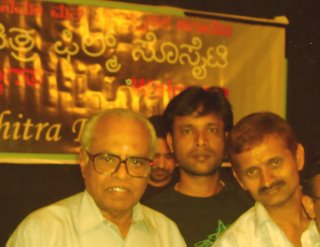CRASH----Being unconventional, is it the convention of the day? On June 10th 2005 a film titled ‘The Bridge of San Luis Rey’ was released in theaters and it was a miserable failure at the box office. This film is in no way connected with the film in context, Crash. This film is an adaptation of Pulitzer Prize winning novel, with the same title, by Thornton Wilder.
The only similarity between the two films, ‘Crash’ and ‘The Bridge of San Luis Rey’ is that both the films deal with multiple interconnected stories, which seems to be the genre of the decade.
The unconventional style of filmmaking, dealing with out a protagonist or with multiple protagonists, featuring an ensemble of independent stories that, somehow, come to end in a finale, where in all the stories and characters mysteriously and unexpectedly collide, find its roots in the book ‘The Bridge of San Luis Rey’.
This book by Thornton Wilder featured the story of a catastrophe—a tiny footbridge in Peru breaks and five people dash to their deaths. For Brother Juniper, a humble monk, the questions were inescapable. Why those five? Was it a chance or the divine intervention that brought them together on that fatal day at that place and that moment of time? Or were they, in some mystical way, to blame for what happened to them?
This kind of story telling is quite new to the art of filmmaking. The first ever attempt of filmmaking with a non-liner narrative and multiple point of views goes back to the 1950’s Japanese film Rashomon by Akira Kurasawa. After that the best-known film with divergent narratives is the ever-famous cult film of the 90’s, ‘pulp fiction’ by Quentin Tarantino. Other successful films that dealt with this exceptional style of narrative structure include,
Amores Perros (Spanish) by Alejandro Gonzalez Inaritu
Traffic (English) by Steven Soderbergh
Suraj ka Saatwan Ghoda (Hindi) by Shyam Benegal
Midaq Alley (Spanish) by Jorge Fons
Magnolia (English) by Paul Thomas Anderson
Apart from these successful films there were quite a few films that tried to create a mosaic of several interrelated stories. One such film is ‘Heights’, directed by Chris Terrio and dealt with desperation and ‘The Bridge of San Luis Rey’ directed by Mary McGukian. These two recent films released in 2004 and 2005, respectively did not stop Crash, this years Oscar winner for best film, directed by Paul Haggis, to went on to become the biggest film of 2005.
The question in discussion here is that, is Crash a conventional film or by trying to be unconventional has it triggered a new convention?
The idea of divergent narratives is no more a device of innovation or novelty, but it is slowly turning in to a screen convention. Is it believable that a hero can hold several bullets in his body and yet survive; where as an extra playing a rowdy will die with just a single bullet. Of course not! We accept it because it is an accepted convention of Indian films.
Crash, which deal with the racism in the everyday lives of Americans, was quite successful at the box office and also at the Oscars. The director, Paul haggis tried to tell the stories of hatred in the name of racism by choosing the overused technique of ‘non linear narrative’. He seemed to have paid the tribute to Quentin Tarantino, the man who started this fire, in two scenes.
Even though Crash went on to become one of the biggest hits of 2005 and its Oscars not many people are happy with the film. Many a people liked the film but majority of them do not vote for its Oscar win. Many say it was just an ‘OK’ kind of film and they find no reason for it to win an Oscar.
The reason for such divided talk is vowed to several reasons. One of it is that Crash is a fantasy film unless you believe that 90% of the people you pass on the streets of America are constantly thinking about racism and are constantly acting on it in severe and extreme ways. This is biggest loophole of the film and to add more, it pretends to be a realistic. But it’s true that there are quite a few brilliant scenes and in the end the film is moving and inspiring in some ways.
Considering the fact that there were not many good films in the competition this year Crash was, in a way, lucky to have won the award. But when compared to the films that dealt with such technique are far superior to Crash and one should not forget that none of them have won an Oscar for best film. This in many ways is a disappointing news to the film lovers around the world, as it clearly indicates the degrading standards in the world of cinema. One thing that clearly shows in Crash is that it is what it is today only because it tried to package a set of similar stories in to a bigger collage and it was the only saving grace of the film supported by brilliant editing. Being unconventional, is it the order of the day? If so the world awaits for one more Quentin Tarantino to start the fire with something new and unconventional.





